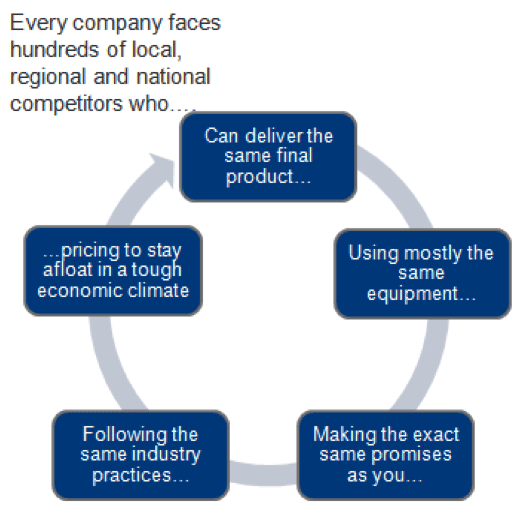About Thinking Creatively
Thinking Creatively is about taking a step back... when you want or need to think strategically and creatively about your business... or about your customer's business... or about a solution to a challenging business problem. The goal is to be one part inspiration and one part motivation. We hope to provide - over time - thought-provoking advice, tools, ideas and company profiles that help get you to your next breakthrough. Your feedback and interaction is invited, welcomed and encouraged.
Thinking Creatively is made possible by the support of GMC Software Technology. Normally such features are for "Premium Members" only. However, because the topic is so timely and essential to all executives in the industry we asked GMC Software Technology to provide support for this series. Their support allows us to to present these articles free for all WhatTheyThink.com members.
Being in a rapidly evolving industry is always challenging. As you decide where to focus your business for the future, you need to understand changing market dynamics… determine where the best opportunities are for your company to grow… and decide when to make important strategic bets.
One thought process that can help as you contemplate your strategic choices is to look outside the industry for inspiration and ideas and new approaches.
In this installment of Thinking Creatively, we’re going to look at two industries that, on the surface, seem very different than the printing and graphic arts industry. Yet, as we look deeper, there are patterns and similarities that can help you make comparisons as you sort out your strategic options.
Who else faces your kind of challenges? I present…the Construction Industry.
So aside from the terrible drop in the entire real estate market…think about how hard it is to stand out in the construction business?
According to Bureau of Labor and Statistics, There were about 884,300 construction establishments in the United States in 2008: 269,700 were building construction contractors and 557,000 were specialty trade contractors. With 7.2 million wage and salary jobs and 1.8 million self-employed and unpaid family workers in 2008, this is one of the nation's largest industries.
What are the similarities to the print business? Consider this:

Sound familiar?
So how can use the construction industry to inspire you?
One core strategic option you have is to specialize. In the construction business, there are hundreds of niches where companies do quite well. At the first level, you can choose to focus on commercial vs. residential building. You can be a new home builder or focus on additions and smaller projects. You can focus an entire business on kitchens and bathrooms.

And you can even drill down deeper. In New Jersey for instance, we have companies like “Doctor Drywall” – owning the very niche specialty of sheetrocking. I have personally used a store called “Moe’s Hardware Distributors”, specializing in cabinet and door hardware (door handles, knobs, etc.). They have thousands of choices, so if you are redoing a kitchen or bathroom, this is the place to go.
One core strategic option you have is to specialize. In the construction business, there are hundreds of niches where companies do quite well.
Another way to use the construction business analogy is to think about the approach to salesmanship. The final product of a construction project is the best tool for selling the next customer. Photos of completed jobs and reference lists of satisfied customers are standard tools of selling (often before and after pictures tell a great story).
Also, think about how new business is sourced. Architects work as a feeder system for bids and jobs for contractors – just as advertising agencies can do the same for you. Are you cultivating a network of creative people and boutiques who can funnel work to you? Also, a construction job usually requires multiple players to complete a project. Are you so good at collaborating and sharing work, so that partners are always happy to work with you?
And finally, the industry analogy applies to business models as well. Think about pricing and the construction industry. There is usually some form of “cost plus” pricing…materials plus labor. I don’t know about you, but one of things I’ve had the biggest arguments over with contractors is “extras” and the cost of them at the end of the job. Pricing is a constant source of suspicion and mistrust. Anyone who successfully solves this problem can pick up a lot of business – and a lot of repeat business.
Another industry always rumored to be on the brink of extinction: The Radio Business
If you had been in the radio business about sixty years ago – at the dawn of the television age – you might have believed the predictions that your industry would disappear.

Our second “analogy industry” – the radio business – marks some striking similarities to the print/graphic arts industry; as television was to the radio business, the digital age is to printing.
As television was to the radio business, the digital age is to printing.
First off, there is the evolution of technology. Think through the various technology changes in printing. Now consider that radio – originally called “wireless” – has moved from AM to FM…to satellite radio with XM/Sirius…to Internet radio and services like Pandora and live streaming of local stations…and now you can get radio on your mobile phone with services like Slacker.
Second, you have some similar customers. Marketers and advertisers are ultimate clients for radio advertising…but so are agencies. And they all are producing work that will ultimately be consumed by end customers – in the case of radio, it is the listeners. The model is B2B2C.
Finally, interesting niches have continued to present themselves. There has been marine radio…CB radio…ham radio…even walkie talkies are considered radio.
How to use the radio industry to inspire you?
There are many variations to the business model that exist for radio. While these don’t translate exactly to the print industry, think open-mindedly about how to change your own business model.
Here are a five different business models in radio:

The listener supported, public radio model.

The subscription model of satellite radio.

The sponsorship model, used in radio’s early days, when soap operas were invented.

Cross channel broadcasting, where radio shows like ESPN’s Mike and Mike in the Morning are also broadcast on television.

Syndication, where programming comes from a national source vs. being produced locally.
On the other end of this spectrum, one of the segments of the radio industry that is growing the fastest is small town, local radio. This corresponds to a media trend occurring in the newspaper business; those that cover small markets and towns tend to be thriving. And this trend is predicted to continue in other areas of commerce; being tied in closely to a local community will continue to present many business opportunities.
This use of other industries to spark creative thought can be expanded. Think about the financial services industry. Banking and brokerage services offer pretty much the same products and services. Finding a unique point of difference in how to deliver those products and services is key.
Being tied in closely to a local community will continue to present many business opportunities.
The consumer packaged goods industry also presents an interesting case to consider. How is it that there are hundreds of detergent brands – each designed to clean clothes – yet resting on very small differences to assert their differentiation (whiter whites, brighter colors, environment-friendly, bargain-priced, concentrated formulas…you get the picture).
With these analogous industries now fresh in your mind, hopefully you can now study their patterns of choices and outcomes and apply them back to your own business. Or, think about using your own personal experiences to reflect on what made you choose one contractor over another, or how you decided to purchase satellite radio or pick a radio station as your favorite.
Overall, the goal is the same; take a step back…think more openly…and think a bit differently…as you deliberate on how your own business should evolve.














